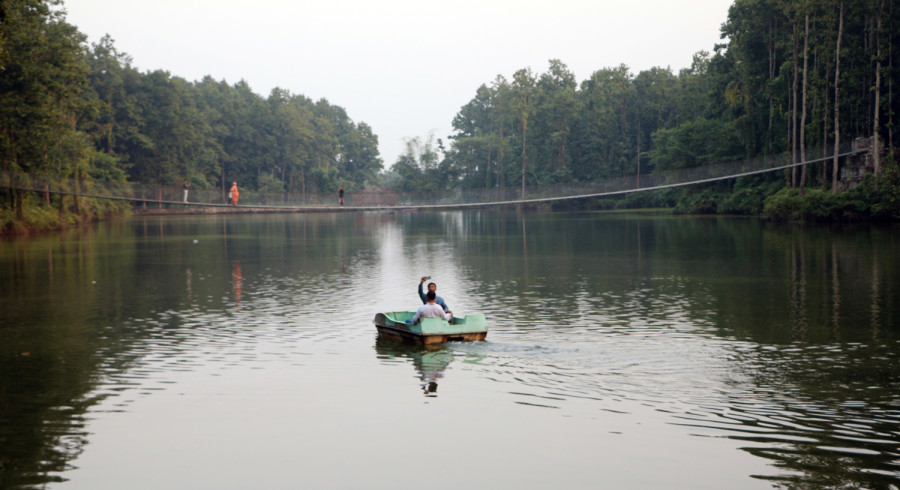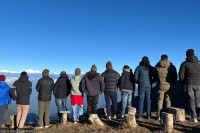National
Haphazard construction of infrastructure in community forests affects ecosystem in Jhapa
Community forest committees seem to be focusing more on earning by adding artificial beauty without paying attention to the environmental aspects.
Arjun Rajbanshi
An artificial pond was constructed on the premises of the wetland inside the Hamse Dumse Community Forest in Damak Municipality last August. The pond was constructed in a bid to promote eco-tourism in the area. However, a few days after the construction, 14-year-old Osim Magar drowned in the pond. Five days later, another local, 20-year-old Madan Shrestha, died after drowning in another pond constructed inside the Pashupati Wetland Area of the same municipality.
District Forest Division Office Chief Bishnu Lal Ghimire said that community forests’ officials have been carrying out haphazard constructions inside the forest land even as the division has time and again informed them about the precautions they must take to conserve the wetlands.
"The members of the community forest committee who have been building ponds and other physical infrastructure in the forest areas are not adhering to the guidelines for the conservation of wetlands," said Ghimire, “We had sent a letter urging each community forest to construct infrastructure keeping in mind the ecology and wildlife while securing artificial ponds with boundary walls.”
Various community forests in Jhapa are competing to attract tourists to its wetlands. In order to do so, the authorities have been haphazardly constructing infrastructure inside the wetlands, especially inside community forests, disregarding the forest regulations and the negative effect of such activities in the ecology and wildlife of the area. As a result, natural streams, springs and ponds of historical and archaeological importance are being destroyed for the sake of revenue generation.
Jamunbari and Sukedaangi community forests in Kankai Municipality and Khuttidangi, Bansbari and Kalika community forests in Mechinagar Municipality have been operating as tourist areas in order to generate income. Large-scale artificial ponds are being constructed inside the forestland flouting the construction regulations and there are no boundary walls surrounding them, making the man-made ponds a risk to visitors.
The forest committee officials have also turned a blind eye to the conservation of wetlands and the safety of visitors. In contrast, they have been demanding additional budget to the local, provincial and federal governments to build concrete infrastructure inside the forestland.
Nabin Baral, chairman of Damak Municipality Ward No. 3, said that the ward has begun cordoning the artificial pond area inside the Hamse Dumse forest.
“We have prioritised the construction of boundary walls around the pond,” said Baral. “We have also allocated Rs4 million to construct a boundary wall around the pond at Pashupati wetlands.”
However, most of the community forests in the district have not adhered to the Forest Act 2019 provision that states that community forests should conserve wetlands. Furthermore, construction works are being carried out without building a bio-corridor for wildlife.
“Water sources must be accessible to the wildlife inside the forest and it should not be tampered with while building infrastructure,” said Ghimire. “A bio corridor should be constructed for the wildlife and wetlands should be conserved, as they are vital to the survival of aquatic and terrestrial animals.”
However, only Bansbari Community Forest has followed the instruction. Ghimire said that the division’s hands are tied as there is no clear regulation that authorises the division to take action against non-complying community forests.
Jamunbari Community Forest Committee Chairman Khyam Sitaula said that all community forests should adhere to strict guidelines when constructing any structure inside forest areas.
“Strong measures must be taken before granting permission for constructing structures inside wetlands,” said Sitaula. “Action must be taken against those who fail to comply with the set regulations.”
Zoologist Prof Dr KR Khambu said that the haphazard construction of structures to earn money without adequate studies could affect the environment.
“Studies and research should be conducted on wetlands before commencing construction works,” said Khambu. “Artificial ponds must not be constructed in such a way that the natural springs dry up. Making the ponds too deep could have a negative impact on aquatic life.”
Khambu further said that the authorities have not been able to conserve the district’s wetlands.
“The decision to make artificial ponds in the wetlands has increased the flow of human traffic in the area. However, the population of various birds and animals, including hawks, tortoises and cranes, among others, are declining,” said Khambu.
The municipality office in Ward No. 3 in Damak decided to build a pond in the Hamse Dumse Community Forest. The municipality wants to turn the wetland into a tourist spot and therefore is taking measures to beautify the area.
A few days after the construction of the said pond, seven-year-old Osim Magar and 20-year-old Madan Shrestha drowned in it.
“We recovered the bodies a day after the incident. Since there are no barricades, the youngsters fell into the pond and died,” said the Area Police Office in Damak
Most community forests— including Krishna Thumki in Mechinagar Ward No. 1, Magurmadi Community Forest in Ward No. 9 and Hatemalo community forest groups in Ward No. 13— in Jhapa are constructing ponds to attract tourists.
Similarly, Dilayo, Bishal and DashrathPur in Bhadrapur Ward No. 1, Chandragadi in Ward No. 9, Sundar Nichajhoda in Birtamod Ward No. 7, Juke Khadi in Arjundhara Ward No. 3 and Prahati forest user group in Ward No. 9 have been building artificial ponds as well.
The municipality in its bid to attract tourists has intensified the construction of ponds and structures inside the community forests. In the process, the municipality has put the fragile ecosystem of the wetlands at risk, say locals.
The Forest Act 2019 says community forests should conserve the wetlands for wildlife. The pathways for wildlife within the forest area should be created and the habitats of the forest should not be harmed. However, the municipality has taken a free reign in the construction of infrastructure inside the community forests, said the head of Division Forest Office, Bishnu Laal Ghimire.
Ghimire informed that they have already issued a circular to all community forests users groups about the guidelines to be followed while building structures inside the forests. Only a few community forests have responded.
Naveen Baral, chairman of Damak Municipality Ward No. 3, said, "We have allocated Rs 4 million for the construction of barricades around the ponds.”
Community forests of Jhapa are home to various wildlife such as elephants, deer, wild boars and monkeys. If the wetlands of forests continue to be destroyed, the animals and plants will lose their home and be at risk of dying out, said Sitaula.




 16.12°C Kathmandu
16.12°C Kathmandu















